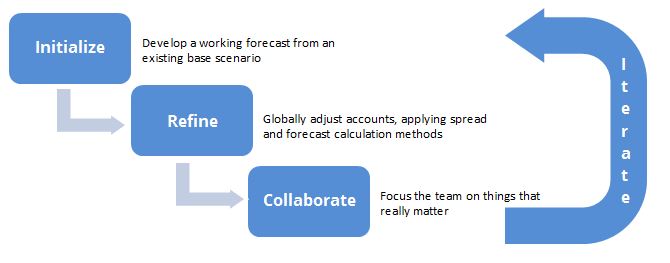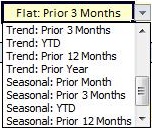Rolling Forecast Automation: Financial Analytics Maximized
Financial analytics and performance monitoring are vital components in an organization’s success. The ability to review and quickly react to industry and market changes is a critical competitive advantage that requires agile analytics to get right. The rolling forecast is a continuous planning process that provides your organization with just such an analytical vehicle. Extending beyond the traditional fiscal year review, it combines actual data with forecast results across a rolling number of periods to provide a consistent analytic horizon. An organization’s rolling forecast process must support variance analyses of performance versus targets using the most current information. This is necessary if they want to recognize and reflect actionable changes that will keep them on or get them back on course.
How a Rolling Forecast Works: Addressing the Elephant in the Room
The rolling forecast should be used as a communication device for the entire organization, executives through managers, to highlight potential future outcomes. Its primary purpose is helping the organization quickly make decisions based on the realities of their current circumstances. It should not try to predict the future, align with the organization’s target, or attempt to merely restate the annual budget. Instead, the rolling forecast should highlight opportunities, risks, and challenges to paint a realistic picture of possible results, allowing managers to promptly take action on the elements within their control in order to positively impact future outcomes.
It’s been said that the only certainty about a forecast is that it will be wrong. For this reason, the best forecasting approaches prepare a range of scenarios offering multiple possible outcomes with low, high, or likely probabilities of occurring. These different variations must be based in reality and provide objective information that exposes departures from the original target or budget. None of them will be 100 percent correct, but they’ll provide a range of possibilities to work from. For this reason, forecast results shouldn’t be used to hold managers accountable to targets or budget. There must be trust and collaboration across the organization so that managers and executives partner together to ensure a valid forecast.
Key Elements: Speed, Timing, Accuracy, Focus
Both speed and timing are every bit as important as accuracy, and all three elements are much more important than detail. To be effective, an organization must be willing to concentrate on forecasting fewer things more often. A zero-based forecast process is not rational, as it does not provide the agility necessary to react in an ever-changing market and can’t serve the true purpose of a forecast. Identifying key business drivers and underlying calculations will lead to usable forecasts from existing business models.
Supporting your forecasting process with the correct technology and design will enable automation of the planning cycle leading to significant efficiency and effectiveness gains. A truly flexible solution will:
- Dynamically update actuals and forecast scenarios.
- Automate spread and forecast methodologies.
- Maintain multiple working versions for comparative analysis, which will enable an entire forecast to be produced in minutes rather than days.
The base of a solid forecasting solution resides in an administrative dashboard or control center developed to support the rapid staging of multiple iterations for each new monthly forecast.
Building a Foundation
The foundation of rapid monthly forecast development is a strong base version that can be used to iterate. From the console of their FPM platform, the administrator should have the ability to quickly generate a working version based on a prior version such as budget, target, previous forecast, or working version. Beneath the covers, the system should then automatically populate the new working forecast with base data for periods defined as forecast while merging it with actual data for earlier months.
After the preparation of a working version, the administrator can then perform global updates, applying spreading functionality and percentage change calculations to further refine the realities of the working iteration directly within the console. These spread methodologies reallocate the working scenario from a selected trend based on a selected version and can also account for percentage increase or decrease adjustments. You can apply this capability to the top level hierarchy or to a select group of accounts so you won’t impact accounts that will likely remain on track to budget, such as Rent Expense.
Rolling Forecasts Deployed: Doing the Heavy Lifting
With the working version deployed to the user community, department managers will have a fully seeded forecast to review instead of surrendering multiple resource hours into building a bottom-up hypothesis. Managers can now strengthen their focus directly on the areas of most concern that threaten the original target or improve the organization’s position. Users can then make manual tweaks to those specific areas or also employ the same spreading and adjustment functionality for a consolidated account group as employed by the administrator.
Once submitted, the administrator can lock the working version and quickly regenerate a second iteration using the initial working version as a baseline. This process can continue until low, high, and/or likely scenarios are generated to provide all the realistic viable potential outcomes worth communicating.
Dashboard controls let you define variances calculations for performance analysis against another stored version. Additional controls allow promoting a working version to lockdown as a final forecast while simultaneously submitting to the reporting environment.
Conclusion
The right solution can truly empower your forecast and improve decision making by allowing your team to quickly identify and focus on the elements of corporate performance that will drive future outcomes. Ironside’s financial performance advisors can help you define a roadmap to move your analytics plans forward. Together we’ll craft an environment that optimizes your budgetary decisions.







